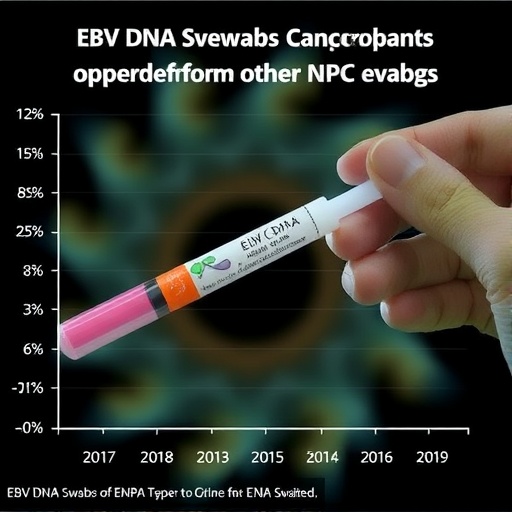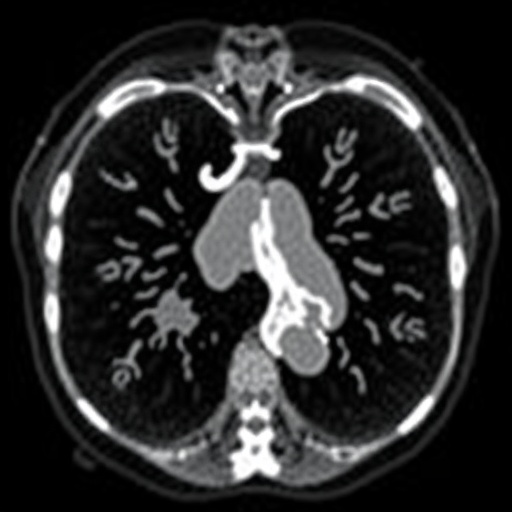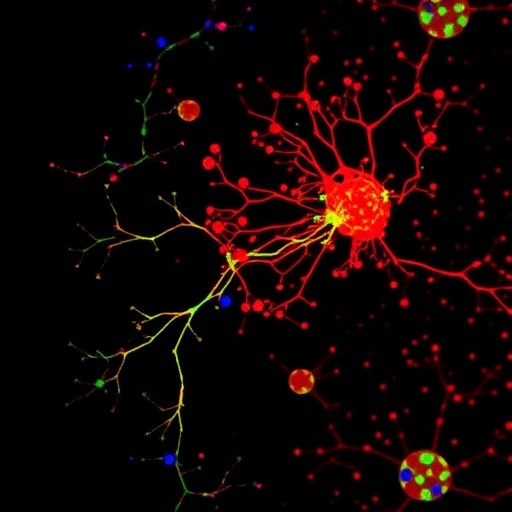
In a groundbreaking study published in BMC Cancer, researchers have unveiled compelling evidence that measuring Epstein-Barr virus (EBV) DNA load in nasopharyngeal swab specimens significantly outperforms plasma and saliva-based approaches for diagnosing nasopharyngeal carcinoma (NPC). This revelation could revolutionize early detection strategies for this aggressive malignancy, especially in endemic regions, by providing a more accurate and less invasive diagnostic method.
Nasopharyngeal carcinoma remains a significant health burden in southern China and other parts of Southeast Asia, where EBV infection is closely linked to tumor development. Traditionally, plasma EBV DNA levels and EBV serology antibody tests have been central pillars in NPC screening and diagnosis. However, differences in sensitivity and specificity among various specimen types have posed challenges in establishing a uniform diagnostic standard. In this context, the current study offers a systematic comparison of EBV DNA load across nasopharyngeal swab (NPS), plasma, and saliva samples, shedding light on the optimal specimen for NPC detection.
The investigative team recruited 150 newly diagnosed NPC patients alongside 150 age- and sex-matched controls without cancer between 2020 and 2021 from two major cancer centers in southern China. Utilizing quantitative polymerase chain reaction (qPCR), they quantified EBV DNA load in NPS, plasma, and saliva samples from all participants. They concurrently evaluated two important EBV serological markers—viral capsid antigen (VCA-lgA) and EBV nuclear antigen 1 (EBNA1-lgA)—through enzyme-linked immunosorbent assay (ELISA) to compare the diagnostic capabilities of molecular and immunological tests.
.adsslot_ApRrEdlzHD{width:728px !important;height:90px !important;}
@media(max-width:1199px){ .adsslot_ApRrEdlzHD{width:468px !important;height:60px !important;}
}
@media(max-width:767px){ .adsslot_ApRrEdlzHD{width:320px !important;height:50px !important;}
}
ADVERTISEMENT
Results revealed a striking disparity in EBV DNA load distribution across specimen types. Both nasopharyngeal swabs and plasma from NPC patients showed significantly higher viral DNA loads compared to controls, while saliva did not exhibit meaningful differences. This finding calls into question the utility of saliva in NPC diagnosis, a specimen that has previously been suggested for its non-invasive collection method yet demonstrated poor discriminatory power in this study.
Importantly, the diagnostic metrics underscored nasopharyngeal swab EBV DNA load as the superior molecular marker. Sensitivity was reported at 92.00% with a specificity of 98.67%, indicating the test’s ability to correctly identify both true positive and true negative cases with remarkable accuracy. In contrast, plasma EBV DNA testing yielded lower sensitivity at 85.33%, though specificity remained comparable at 98.67%. These results indicate that NPS testing detects more NPC cases accurately while maintaining a minimal false positive rate.
The EBV serology antibody score, which has been conventionally utilized for NPC screening, demonstrated a sensitivity of 94.67% but showed decreased specificity at 90.00%. This contrast highlights the trade-off between different diagnostic approaches: serological tests capture more true positives but allow more false positives, whereas NPS EBV DNA testing balances high sensitivity with excellent specificity. Intriguingly, when combining NPS EBV DNA load with the antibody score, specificity further improved to 99.33% without a substantial drop in sensitivity (88.67%), revealing a potent integrative strategy for enhancing NPC diagnosis.
These findings have important clinical implications. Nasopharyngeal swabbing is a minimally invasive procedure easily performed in outpatient settings, offering a practical advantage over venipuncture for plasma collection. Increased diagnostic accuracy can lead to earlier detection, critical for improving patient outcomes given the aggressiveness and often late presentation of NPC. Moreover, the demonstrated poor diagnostic value of saliva EBV DNA negates its role in NPC screening, guiding future resource allocation and research focus.
EBV plays a fundamental oncogenic role in NPC pathogenesis, and its viral load correlates with tumor burden. The ability of nasopharyngeal swabs to harbor higher EBV DNA concentrations likely derives from their anatomical proximity to the tumor site. This proximity enables detection of local viral DNA shedding, whereas plasma reflects systemic circulation and saliva may contain diluted or transient viral presence. The qPCR detection technique’s high sensitivity enables quantification of minute DNA fragments, underpinning the clinical utility of NPS EBV DNA load as a biomarker.
The integration of molecular viral load testing with serology-based immune markers represents a holistic approach toward NPC diagnosis. This multimodal strategy balances the high sensitivity of antibody detection with the superior specificity of localized viral DNA measurement, reducing false positives that can cause patient anxiety and unnecessary interventions. Clinical workflows adopting this combined methodology may streamline screening in endemic populations, optimize resource use, and potentially serve as a model for other EBV-associated malignancies.
Future research should explore the longitudinal utility of NPS EBV DNA testing in monitoring therapeutic response and detecting recurrence post-treatment. Additionally, standardizing swab collection techniques and qPCR protocols will be essential for broader clinical implementation. Investigating potential cost-effectiveness and patient acceptability compared to existing screening methods will further support integration into national diagnostic guidelines.
In conclusion, this seminal study firmly establishes EBV DNA load detection in nasopharyngeal swabs as a superior diagnostic tool for NPC in endemic areas. By outperforming plasma- and saliva-based approaches, the nasopharyngeal swab test offers a highly sensitive, specific, and clinically feasible method. Coupling this approach with conventional EBV antibody scoring enhances diagnostic precision, paving the way for improved early detection and ultimately, better prognoses for NPC patients.
The work not only advances our understanding of viral biomarker compartmentalization but also has profound translational potential amid global efforts to mitigate EBV-driven cancers. Nasopharyngeal swab testing could become a frontline strategy for NPC diagnosis, especially valuable in resource-limited environments where maximizing diagnostic yield is paramount.
As the global scientific community continues to unravel the complexities of virus-associated malignancies, studies like this highlight the importance of specimen selection, assay sensitivity, and integrated diagnostic frameworks. The future of NPC diagnosis now appears poised for transformation thanks to the elegant simplicity and superior performance of EBV DNA testing directly from the nasopharynx.
Subject of Research: Diagnostic performance comparison of EBV DNA load testing in various specimens for nasopharyngeal carcinoma detection.
Article Title: Diagnostic performance of EBV DNA load testing for nasopharyngeal carcinoma in nasopharyngeal swab outperforms the approach in other specimens.
Article References:
Li, XQ., Lin, DF., Cai, YC. et al. Diagnostic performance of EBV DNA load testing for nasopharyngeal carcinoma in nasopharyngeal swab outperforms the approach in other specimens.
BMC Cancer 25, 1126 (2025). https://doi.org/10.1186/s12885-025-14539-5
Image Credits: Scienmag.com
DOI: https://doi.org/10.1186/s12885-025-14539-5
Tags: cancer screening in Southeast AsiaEBV DNA load in nasopharyngeal swabsEBV infection and tumor developmentEpstein-Barr virus diagnosishealth burden of nasopharyngeal carcinomainnovative cancer detection strategiesnasopharyngeal carcinoma early detectionnon-invasive cancer diagnostic methodsNPC diagnostic accuracyplasma versus saliva NPC testingqPCR in cancer researchsystematic comparison of diagnostic specimens





